Abstract
Parasite-specific humoral and cellular immune responses were evaluated in in nine immunosuppressed patients with Strongyloides stercoralis infection. Four patients had the disseminated form of the disease, and five had serious manifestations without evidence of hyperinfection. All patients had high levels of immunoglobulin G (IgG) antibodies directed against S. stercoralis larval antigens as detected by the enzyme-linked immunosorbent assay. Seven patients had both elevated total serum IgE and parasite-specific IgE antibodies detected by a modified radioimmunoassay. The hyperinfected patients differed significantly from the nonhyperinfected group in total and specific IgE levels and peripheral eosinophilia but not in specific IgG levels. None of the patients tested exhibited significant in vitro lymphoproliferative responses to parasite antigens. Our results indicated that the possibility of a protective role of IgE and eosinophils in strongyloidiasis deserves further investigation. In addition, we suggest that the enzyme-linked immunosorbent assay for specific IgG antibodies may have an important place in the diagnosis of strongyloidiasis in immunocompetent as well as in immunocompromised patients.
Full text
PDF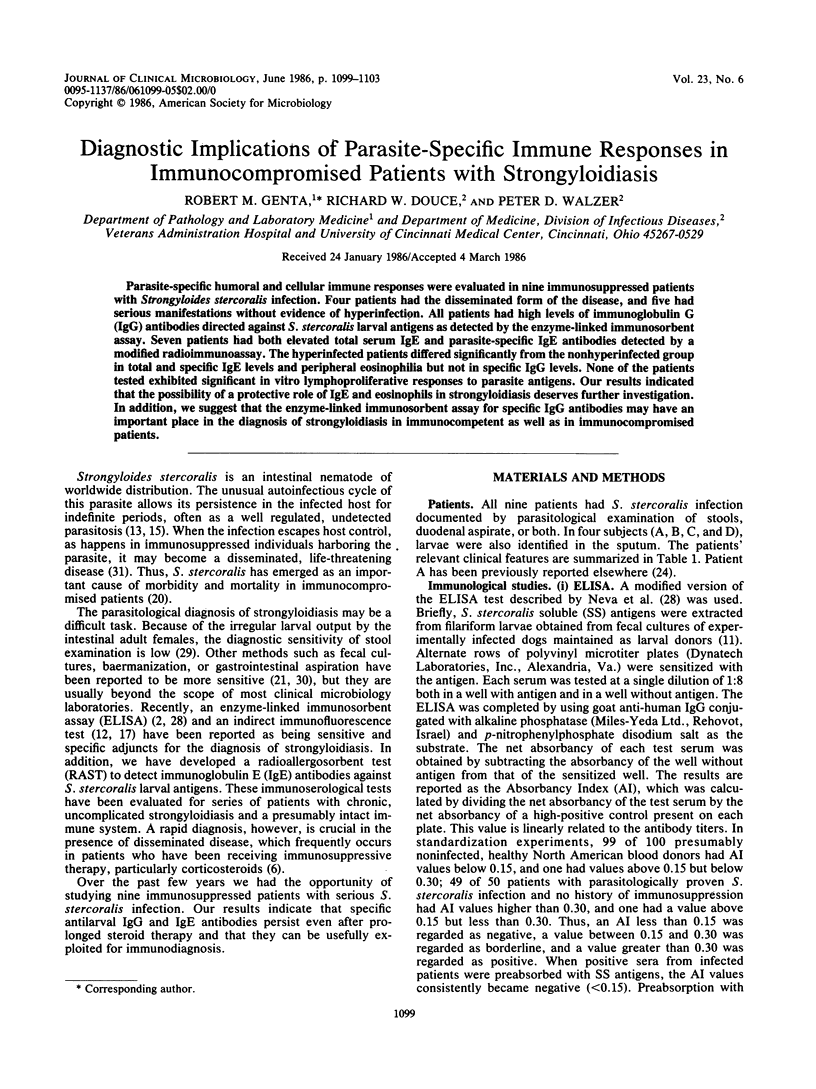
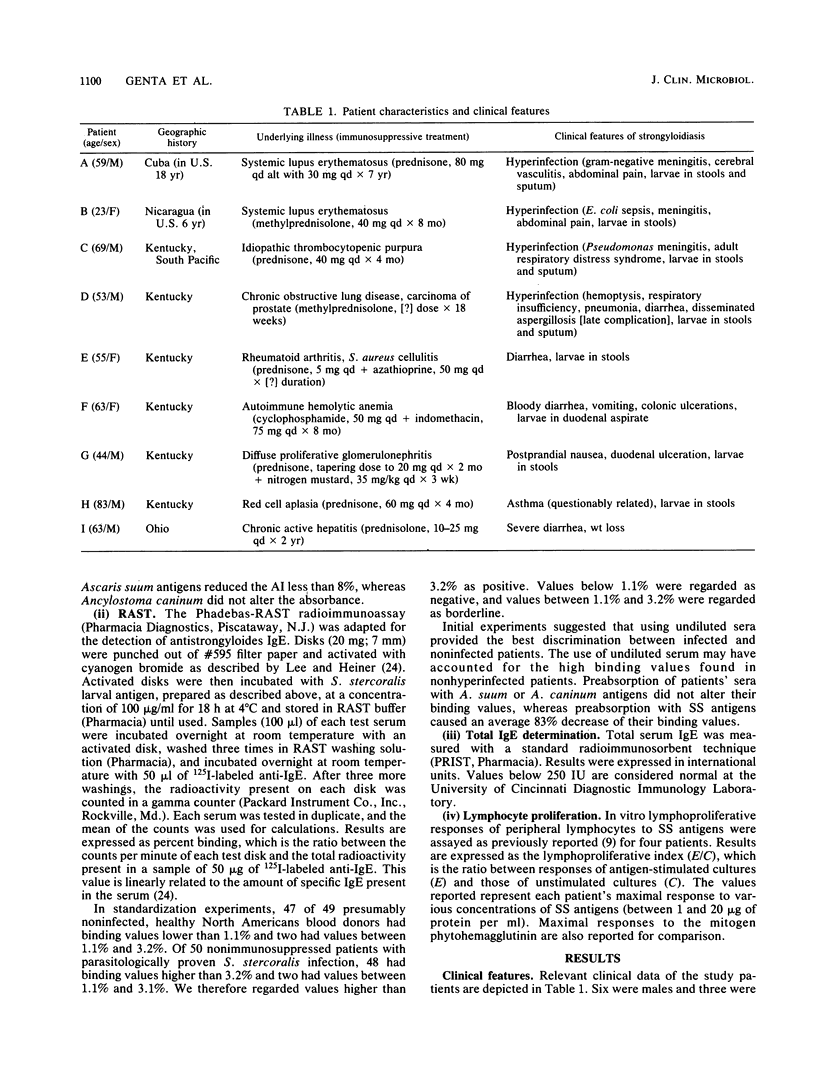
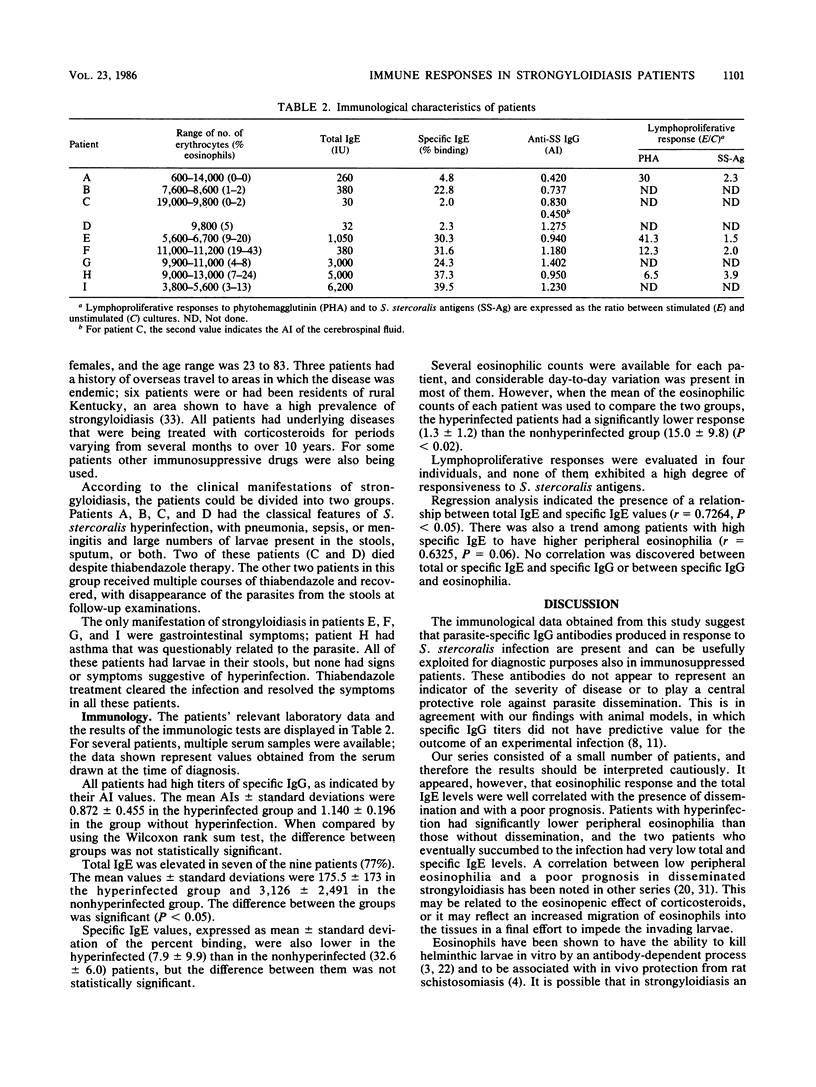
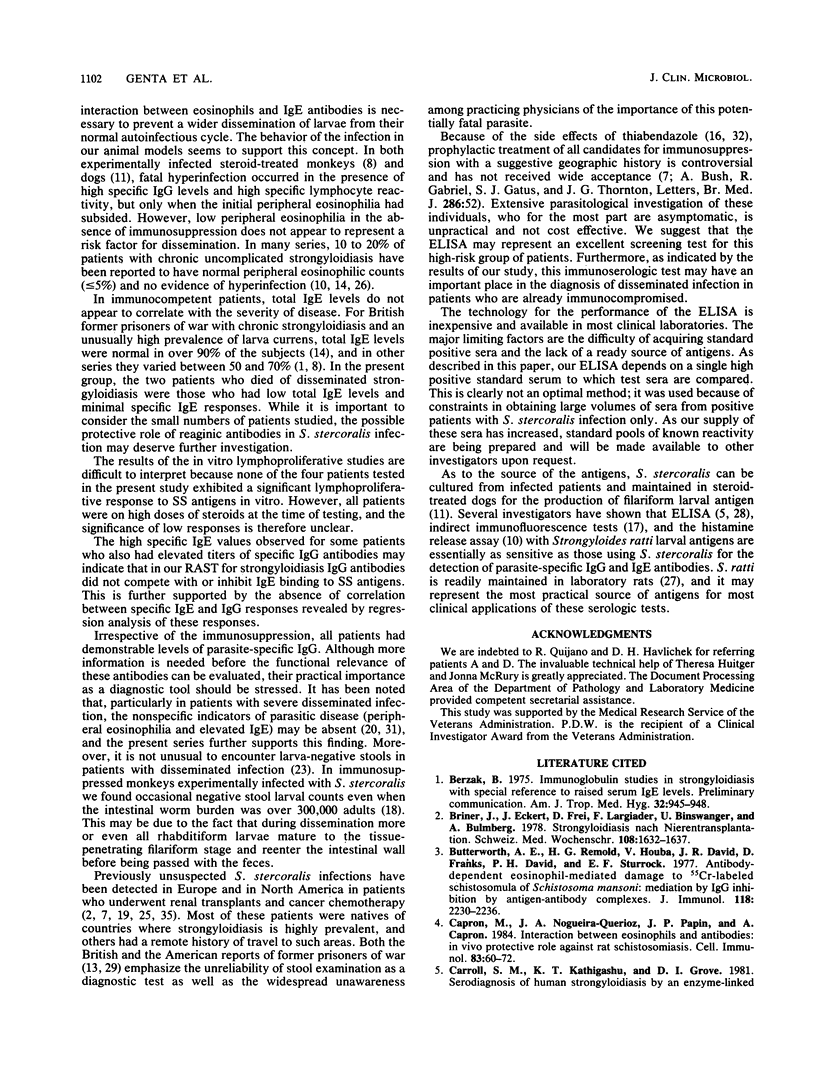
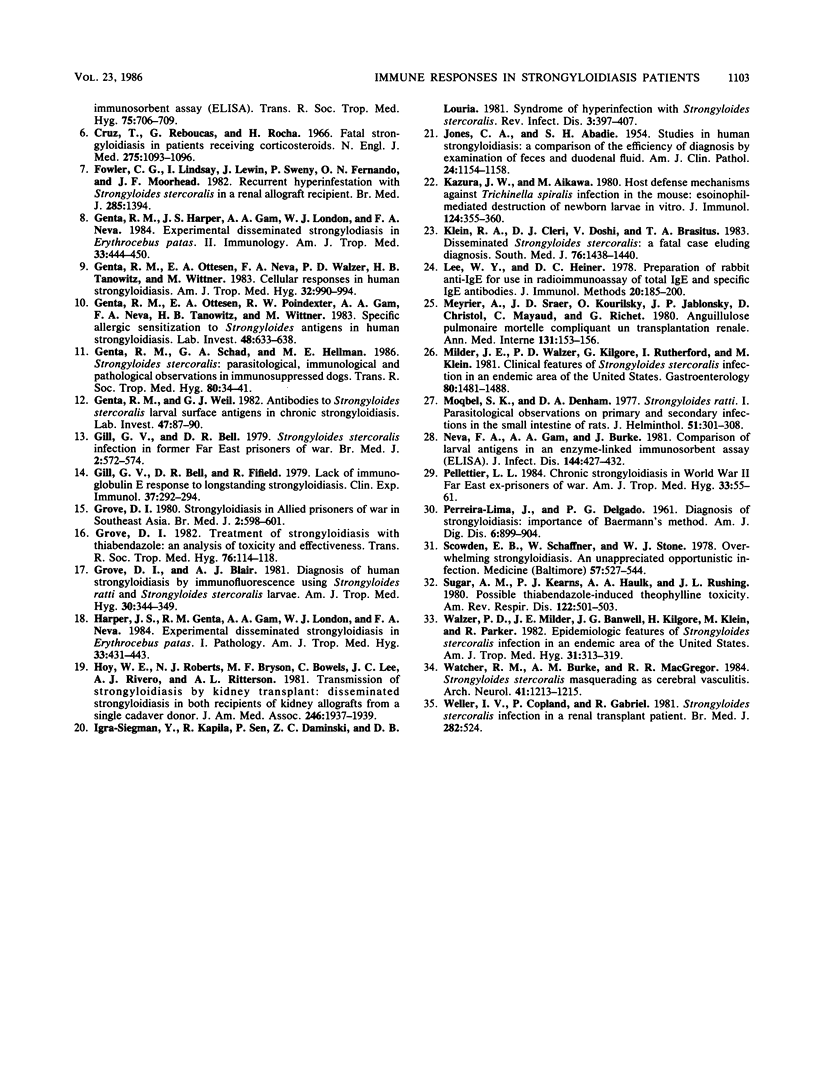
Selected References
These references are in PubMed. This may not be the complete list of references from this article.
- Briner J., Eckert J., Frei D., Largiadèr F., Binswanger U., Blumberg A. Strongyloidiasis nach Nierentransplantation. Schweiz Med Wochenschr. 1978 Oct 21;108(42):1632–1637. [PubMed] [Google Scholar]
- Butterworth A. E., Remold H. G., Houba V., David J. R., Franks D., David P. H., Sturrock R. F. Antibody-dependent eosinophil-mediated damage to 51Cr-labeled schistosomula of Schistosoma mansoni: mediation by IgG, and inhibition by antigen-antibody complexes. J Immunol. 1977 Jun;118(6):2230–2236. [PubMed] [Google Scholar]
- Capron M., Nogueira-Queiroz J. A., Papin J. P., Capron A. Interactions between eosinophils and antibodies: in vivo protective role against rat schistosomiasis. Cell Immunol. 1984 Jan;83(1):60–72. doi: 10.1016/0008-8749(84)90225-9. [DOI] [PubMed] [Google Scholar]
- Carroll S. M., Karthigasu K. T., Grove D. I. Serodiagnosis of human strongyloidiasis by an enzyme-linked immunosorbent assay. Trans R Soc Trop Med Hyg. 1981;75(5):706–709. doi: 10.1016/0035-9203(81)90156-5. [DOI] [PubMed] [Google Scholar]
- Cruz T., Reboucas G., Rocha H. Fatal strongyloidiasis in patients receiving corticosteroids. N Engl J Med. 1966 Nov 17;275(20):1093–1096. doi: 10.1056/NEJM196611172752003. [DOI] [PubMed] [Google Scholar]
- Fowler C. G., Lindsay I., Levin J., Sweny P., Fernando O. N., Moorhead J. F. Recurrent hyperinfestation with Strongyloides stercoralis in a renal allograft recipient. Br Med J (Clin Res Ed) 1982 Nov 13;285(6352):1394–1394. doi: 10.1136/bmj.285.6352.1394. [DOI] [PMC free article] [PubMed] [Google Scholar]
- Genta R. M., Harper J. S., 3rd, Gam A. A., London W. I., Neva F. A. Experimental disseminated strongyloidiasis in Erythrocebus patas. II. Immunology. Am J Trop Med Hyg. 1984 May;33(3):444–450. doi: 10.4269/ajtmh.1984.33.444. [DOI] [PubMed] [Google Scholar]
- Genta R. M., Ottesen E. A., Neva F. A., Walzer P. D., Tanowitz H. B., Wittner M. Cellular responses in human strongyloidiasis. Am J Trop Med Hyg. 1983 Sep;32(5):990–994. doi: 10.4269/ajtmh.1983.32.990. [DOI] [PubMed] [Google Scholar]
- Genta R. M., Ottesen E. A., Poindexter R., Gam A. A., Neva F. A., Tanowitz H. B., Wittner M. Specific allergic sensitization to Strongyloides antigens in human strongyloidiasis. Lab Invest. 1983 May;48(5):633–638. [PubMed] [Google Scholar]
- Genta R. M., Schad G. A., Hellman M. E. Strongyloides stercoralis: parasitological, immunological and pathological observations in immunosuppressed dogs. Trans R Soc Trop Med Hyg. 1986;80(1):34–41. doi: 10.1016/0035-9203(86)90190-2. [DOI] [PubMed] [Google Scholar]
- Genta R. M., Weil G. J. Antibodies to Strongyloides stercoralis larval surface antigens in chronic strongyloidiasis. Lab Invest. 1982 Jul;47(1):87–90. [PubMed] [Google Scholar]
- Gill G. V., Bell D. R., Fifield R. Lack of immunoglobulin E response to longstanding strongyloidiasis. Clin Exp Immunol. 1979 Aug;37(2):292–294. [PMC free article] [PubMed] [Google Scholar]
- Gill G. V., Bell D. R. Strongyloides stercoralis infection in former Far East prisoners of war. Br Med J. 1979 Sep 8;2(6190):572–574. doi: 10.1136/bmj.2.6190.572. [DOI] [PMC free article] [PubMed] [Google Scholar]
- Grove D. I., Blair A. J. Diagnosis of human strongyloidiasis by immunofluorescence, using Strongyloides ratti and S. stercoralis larvae. Am J Trop Med Hyg. 1981 Mar;30(2):344–349. doi: 10.4269/ajtmh.1981.30.344. [DOI] [PubMed] [Google Scholar]
- Grove D. I. Strongyloidiasis in Allied ex-prisoners of war in south-east Asia. Br Med J. 1980 Mar 1;280(6214):598–601. doi: 10.1136/bmj.280.6214.598. [DOI] [PMC free article] [PubMed] [Google Scholar]
- Grove D. I. Treatment of strongyloidiasis with thiabendazole: an analysis of toxicity and effectiveness. Trans R Soc Trop Med Hyg. 1982;76(1):114–118. doi: 10.1016/0035-9203(82)90034-7. [DOI] [PubMed] [Google Scholar]
- Harper J. S., 3rd, Genta R. M., Gam A., London W. T., Neva F. A. Experimental disseminated strongyloidiasis in Erythrocebus patas. I. Pathology. Am J Trop Med Hyg. 1984 May;33(3):431–443. doi: 10.4269/ajtmh.1984.33.431. [DOI] [PubMed] [Google Scholar]
- Hoy W. E., Roberts N. J., Jr, Bryson M. F., Bowles C., Lee J. C., Rivero A. J., Ritterson A. L. Transmission of strongyloidiasis by kidney transplant? Disseminated strongyloidiasis in both recipients of kidney allografts from a single cadaver donor. JAMA. 1981 Oct 23;246(17):1937–1939. [PubMed] [Google Scholar]
- Igra-Siegman Y., Kapila R., Sen P., Kaminski Z. C., Louria D. B. Syndrome of hyperinfection with Strongyloides stercoralis. Rev Infect Dis. 1981 May-Jun;3(3):397–407. doi: 10.1093/clinids/3.3.397. [DOI] [PubMed] [Google Scholar]
- JONES C. A., ABADIE S. H. Studies in human strongyloidiasis. II. A comparison of the efficiency of diagnosis by examination of feces and duodenal fluid. Am J Clin Pathol. 1954 Oct;24(10):1154–1158. doi: 10.1093/ajcp/24.10.1154. [DOI] [PubMed] [Google Scholar]
- Kazura J. W., Aikawa M. Host defense mechanisms against Trichinella spiralis infection in the mouse: eosinophil-mediated destruction of newborn larvae in vitro. J Immunol. 1980 Jan;124(1):355–361. [PubMed] [Google Scholar]
- Klein R. A., Cleri D. J., Doshi V., Brasitus T. A. Disseminated Strongyloides stercoralis: a fatal case eluding diagnosis. South Med J. 1983 Nov;76(11):1438–1440. doi: 10.1097/00007611-198311000-00030. [DOI] [PubMed] [Google Scholar]
- LIMA J. P., DELGADO P. G. Diagnosis of strongyloidiasis: importance of Baermann's method. Am J Dig Dis. 1961 Sep;6:899–904. doi: 10.1007/BF02231086. [DOI] [PubMed] [Google Scholar]
- Lee W. Y., Heiner D. C. Preparation of rabbit anti-IgE for use in radioimmunoassays of total IgE and specific IgE antibodies. J Immunol Methods. 1978;20:185–200. doi: 10.1016/0022-1759(78)90255-7. [DOI] [PubMed] [Google Scholar]
- Milder J. E., Walzer P. D., Kilgore G., Rutherford I., Klein M. Clinical features of Strongyloides stercoralis infection in an endemic area of the United States. Gastroenterology. 1981 Jun;80(6):1481–1488. [PubMed] [Google Scholar]
- Moqbel R., Denham D. A. Strongyloides ratti: 1. parasitological observations on primary and secondary infections in the small intestine of rats. J Helminthol. 1977;51(4):301–308. doi: 10.1017/s0022149x0000763x. [DOI] [PubMed] [Google Scholar]
- Neva F. A., Gam A. A., Burke J. Comparison of larval antigens in an enzyme-linked immunosorbent assay for strongyloidiasis in humans. J Infect Dis. 1981 Nov;144(5):427–432. doi: 10.1093/infdis/144.5.427. [DOI] [PubMed] [Google Scholar]
- Pelletier L. L., Jr Chronic strongyloidiasis in World War II Far East ex-prisoners of war. Am J Trop Med Hyg. 1984 Jan;33(1):55–61. doi: 10.4269/ajtmh.1984.33.55. [DOI] [PubMed] [Google Scholar]
- Scowden E. B., Schaffner W., Stone W. J. Overwhelming strongyloidiasis: an unappreciated opportunistic infection. Medicine (Baltimore) 1978 Nov;57(6):527–544. [PubMed] [Google Scholar]
- Sugar A. M., Kearns P. J., Jr, Haulk A. A., Rushing J. L. Possible thiabendazole-induced theophylline toxicity. Am Rev Respir Dis. 1980 Sep;122(3):501–503. doi: 10.1164/arrd.1980.122.3.501. [DOI] [PubMed] [Google Scholar]
- Wachter R. M., Burke A. M., MacGregor R. R. Strongyloides stercoralis hyperinfection masquerading as cerebral vasculitis. Arch Neurol. 1984 Nov;41(11):1213–1216. doi: 10.1001/archneur.1984.04050220115030. [DOI] [PubMed] [Google Scholar]
- Walzer P. D., Milder J. E., Banwell J. G., Kilgore G., Klein M., Parker R. Epidemiologic features of Strongyloides stercoralis infection in an endemic area of the United States. Am J Trop Med Hyg. 1982 Mar;31(2):313–319. doi: 10.4269/ajtmh.1982.31.313. [DOI] [PubMed] [Google Scholar]
- Weller I. V., Copland P., Gabriel R. Strongyloides stercoralis infection in renal transplant recipients. Br Med J (Clin Res Ed) 1981 Feb 14;282(6263):524–524. doi: 10.1136/bmj.282.6263.524. [DOI] [PMC free article] [PubMed] [Google Scholar]


